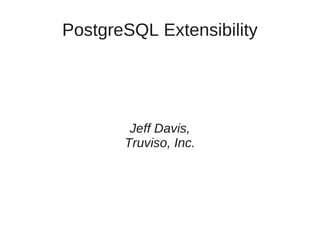
PostgreSQL, Extensible to the Nth Degree: Functions, Languages, Types, Rules, Performance, and More!
- 1. PostgreSQL Extensibility Jeff Davis, Truviso, Inc.
- 2. Introduction ● Many businesses have needs that are specific to the industry or to the business itself – Not always met by generic tools offered by a DBMS ● People in that business know best how to solve those problems ● But those people may not be database engine developers
- 3. And Also... When implementing a workaround on a running system, you want every possible option available.
- 4. Outline ● How to solve domain-specific problems – Solutions should be as seamless as a native feature, not bolted on. ● How to make those solutions perform like a special-purpose solution ● How to build complete features without modifying the core database engine ● Where these features fit into the PostgreSQL development landscape
- 5. Extensibility Overview ● Functions – procedural code that can be written in a variety of languages ● Operators – define the behavior of your type and allow it to be usefully indexed ● Types – input/output ● Index Support – define sophisticated indexing behavior for your data type ● Procedural languages
- 6. Functions ● Can be written in a variety of languages – PL/pgSQL, C, Perl, Python, and more ● Fundamental part of extensibility architecture ● Used for – Operators – Type input/output functions – Index support routines – etc.
- 7. Operators ● Allowable characters – +-*/<>=~!@#%^&|`? ● Can be infix, postfix, or prefix ● Allow index searches
- 8. Types ● Types help you represent data the way that makes sense to your business ● User-defined types are given all the power of native types – Not slower – Not less flexible – Not less indexable ● Define input/output, storage, etc.
- 9. Index Access Methods ● BTree ● GiST ● GIN ● You implement your specialized indexing algorithm using index support functions ● You don't need to worry about low level details like page splits or the transaction log (WAL)
- 10. Example: PostGIS ● Spatial data – implements OpenGIS – Collections of lines, points, polygons, etc. ● Important queries – Contains – Overlaps ● Existing data types can't represent the data effectively ● BTree can't index effectively, no useful total order for spatial types
- 11. PostGIS: Types ● Geometry type can hold – points – linestrings – polygons – etc. ● A single geometry value can hold a combination of all of those
- 12. PostGIS: operators ● && - overlaps ● << - strictly left of ● >> - strictly right of ● ~= - is the same as ● ~ - contains ● @ - is contained by
- 13. PostGIS: indexes ● Uses GiST, a sophisticated generalized index access method with a tree structure. ● GiST is much more general than BTree. It can search for matches based on what makes sense for your problem, using algorithms that you supply via functions. ● Still has all the safety of the write-ahead log.
- 14. Example: DBI-Link ● Allows you to access any data source available via Perl's DBI ● Remote data is seen as a table in PostgreSQL ● How?
- 15. DBI-Link: PL/Perlu ● PL/Perlu is the “untrusted” (i.e. not sandboxed) version of the perl procedural language. ● Can execute arbitrary code, including creating sockets, etc. ● And therefore, it can use Perl's DBI to access any data over a network.
- 16. DBI-Link: SRFs ● DBI-Link uses Set Returning Functions, or SRFs ● Function returns multiple rows to PostgreSQL ● Is used in place of a table.
- 17. Example: PL/proxy ● Access remote PostgreSQL data ● Designed to be easy to retrieve data from many different PostgreSQL nodes ● Supports partitioning ● Implemented as its own language
- 18. PL/proxy: example CREATE OR REPLACE FUNCTION get_user_email(i_username text) RETURNS SETOF text AS $$ CLUSTER 'usercluster'; RUN ON hashtext(i_username) ; SELECT email FROM users WHERE username = i_username; $$ LANGUAGE plproxy;
- 19. Example: Full Text Search ● Search for matches within a document. ● The primary query is “contains” ● Problem: BTree unsuitable, documents do not have a useful total order. ● Problem: Text type is unsuitable – Lists the same word many times, doesn't eliminate stopwords – Doesn't equate words with same root
- 20. Full Text Search: Types ● tsquery – type suitable for representing queries – to_tsquery('bears & eat') – 'bear' & 'eat' ● tsvector – document representation suitable for indexed searches – to_tsvector('Bears eat everything.') – 'eat':2 'bear':1 'everyth':3
- 21. Full Text Search: Indexes ● Indexable Operator - @@ – Means “matches the query” ● Index Access methods – GIN – better query performance and scalability – GiST – better update performance ● GiST is such a generic index interface, it can be used for indexing spatial data and full text data
- 22. Full Text Search: 8.3 ● Full Text Search lived as a fully functional separate module, including index support, since 2002. ● Was very successful and useful to many people ● Included in PostgreSQL 8.3 ● The fact that such a major feature was fully functional completely outside of the core PostgreSQL product shows the power of the extensible architecture.
- 23. Development Landscape ● Variety of projects outside of PostgreSQL core – http://www.pgfoundry.org ● Advantages – Separate release cycle – Separate development – Users can pick and choose what fits them best among alternative solutions ● Disadvantages – Can't extend SQL language
- 24. Conclusion ● Extensibility allows people with knowledge in specific problem domains to create major features without dealing with database internals. ● More efficient development by making independent projects ● Enables businesses to solve practical problems quickly and cheaply, without extensive error- prone “glue” code. ● Doesn't require interrupting normal operation!
